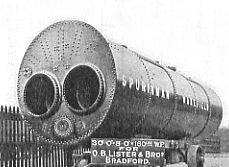PONTYPOOL GLYN PITS
Cylinder and Condenser

This is the Beam Engine, and in the top left of the picture is the engine cylinder. It has a 30-inch bore and a stroke of 6 feet. This activated the beam in an up and down rocking motion. The piston was double-acting in that it received steam both ends of the cylinder. In the case of this engine, the exhaust was not wasted to the atmosphere but was captured in a condenser seen between the cylinder and the air pump. The condenser was invented in 1765 by James Watt. This one was immersed in a tank of cold water, called the 'Cold well', which kept the condenser cool, this had the effect of condensing the exhaust steam, creating a vacuum to assist the engine, and also giving a supply of hot water for boiler feed. This hot water and entrained air was removed by the air pump on the right of the picture. As the beam rocked it caused the air pump piston, which was also attached to the beam by the vertical rod seen over the air pump to rise and fall, discharging the hot water through a channel (seen on the right of the air pump cylinder) which in turn led to another tank called a 'Hot well', this was situated at the rear of the original boiler house from where the now still hot water could be reused in the boilers.


This is a picture of a steam boiler, one of which was used in later years at the Old Glyn Pits. This type was used locally in almost all the collieries and iron and tin works. The boiler illustrated is a 'Lancashire type', but the original boilers - two - at the Glyn were of the 'Cornish' type which were used for the beam engine. These were identical to the Lancashire type except in size, the Cornish boilers were usually slightly smaller - and they were fitted with only one fire-tube. The two tubes seen in the boiler above were the flue-tubes, and the fire-box, about six feet in length- was situated in the end nearest the camera, and had a furnace door fitted to each one through which coal was fed to the fires. This particular boiler is 30 feet long and 8 feet diameter, with a working pressure of 160 pounds per square inch. This boiler, made by the British firm of Spurr Inman, was typical of high-quality nineteenth & twentieth-century British engineering practice.